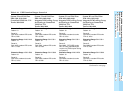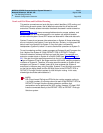
MERLIN LEGEND Communications System Release 6.1
Network Reference
555-661-150
Issue 1
August 1998
Call-Handling Scenarios
Page 2-83Network Configuration Scenarios
2
Table 2–20. Scenario 4: Facilities Planning, Calls Originating within the Network and Going to the PSTN: System E and H,
Continued
Component System E: Baltimore, MD (Area Code: 410) System H: Reston, VA (Area Code: 703)
ARS Routing:
Calls to Area Code
of Non-Local
System
(Absorb = 0;
Prepend = 9)
For primary routes serving calls to area codes 509 and
512, the FRL is 0.
The FRL is higher for primary routes to areas near but not
in the same area code as one of the other private network
systems. A 218 or 713 area code route (Houston) via the
smaller tandem tie trunk pool has an FRL of 4.
Secondary routes using the PSTN have FRLs as high
as 6.
Routing specifies pools of tandem PRI facilities, which are
also used for non-local extension calling.
The FRL is 0, 1, or 2 for calls using private network area
codes: 410, 512, and 509. FRLs are higher for other area
codes, depending upon the time of day and toll costs.
Centralized
VMS/AA
Integrated VMI calling group extension: 7771
Local dial plan members: Extensions for system ports
used to connect centralized VMS/AA
Message Waiting light updates for non-local subscribers
at System F and System H are sent over the tandem PRI
signaling D-channel; Message Waiting light updates for
non-local subscribers at System G are sent over the
tandem tie trunks;
Integrated VMI calling group extension: 7771
VMI conversion number (non-local dial plan member:
6999
UDP routing over route 01, tandem PRI trunks, FRL=0,
voice, all dialed digits are absorbed and the digits 7771
are prepended.


















